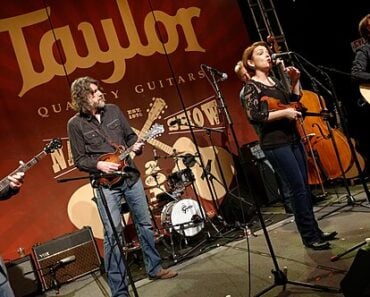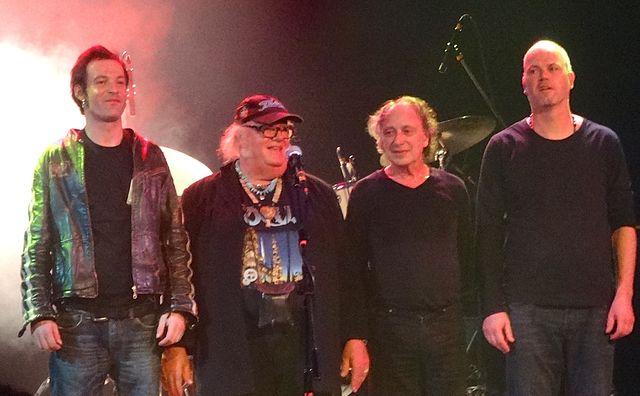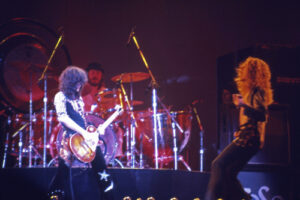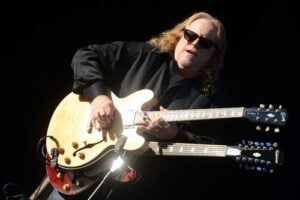
Feature Photo: Bruce Alan Bennett / Shutterstock.com
The band formed in New York City in 1971 and released two original studio albums before disbanding in 1976. The group later reunited in 2004 and produced three additional albums before their final disbandment in 2011.
Throughout their existence, the band saw multiple lineup changes but maintained their core identity as pioneers of both glam rock and proto-punk music. The band achieved limited commercial success during their initial run, with neither of their 1970s albums charting significantly. However, their influence far exceeded their sales figures, with countless punk and alternative rock bands citing them as a primary inspiration.
The New York Dolls’ two original albums, their self-titled 1973 debut and 1974’s “Too Much Too Soon,” later gained critical acclaim and were recognized as foundational works in rock history. Rolling Stone magazine eventually included their debut album in their list of the 500 Greatest Albums of All Time. By 2025, all original members of the New York Dolls had passed away, marking the end of an era for one of rock’s most influential bands.
David Johansen
David Johansen served as the charismatic frontman and primary lyricist for the New York Dolls from their formation in 1971 until their dissolution in 1976. Born on January 9, 1950, in Staten Island, New York, Johansen was recruited by Arthur Kane to join the band after Kane and Billy Murcia had approached him about forming a group. Johansen’s distinctive voice and Mick Jagger-influenced stage presence became central to the band’s identity.
He performed on both of the Dolls’ original studio albums, co-writing many of their most memorable songs including “Personality Crisis” and “Trash.” His lyrics often reflected urban experiences and personal relationships with a raw honesty that would become characteristic of punk rock. After the band’s breakup, Johansen pursued a successful solo career, releasing multiple albums throughout the late 1970s and 1980s.
His most commercially successful venture came when he reinvented himself as Buster Poindexter, a pompadoured lounge singer who scored a major hit with “Hot Hot Hot” in 1987. Johansen also branched into acting, appearing in films such as “Scrooged,” “Married to the Mob,” and “Let It Ride.” He reunited with surviving Dolls members in 2004 for their comeback, performing on all three reunion albums.
Johansen continued performing and recording until his death from cancer on March 1, 2025, at age 75. He was the last surviving original member of the New York Dolls. His legacy includes both his groundbreaking work with the Dolls and his successful reinvention as a solo artist and entertainer.
Johnny Thunders
Johnny Thunders, born John Anthony Genzale on July 15, 1952, in Queens, New York, was the lead guitarist for the New York Dolls from 1971 to 1975. He initially joined the band as a bassist but was taught guitar by Sylvain Sylvain and quickly became their primary guitarist. Thunders developed a distinctive raw, distorted guitar sound that became a blueprint for punk rock guitar playing.
His aggressive, sloppy style prioritized attitude over technical precision, influencing countless guitarists who followed. He played on both New York Dolls studio albums, contributing to classics like “Personality Crisis” and “Looking for a Kiss.” Thunders left the band in March 1975 along with drummer Jerry Nolan due to internal conflicts and drug-related issues.
After leaving the Dolls, he formed The Heartbreakers with Nolan and ex-Television bassist Richard Hell. The Heartbreakers became a significant force in the emerging punk scene, touring with the Sex Pistols on their infamous Anarchy Tour in 1976. The band released one studio album, “L.A.M.F.” in 1977, which despite production problems became a punk classic.
Thunders also pursued a solo career, releasing the critically acclaimed album “So Alone” in 1978. This album featured guest appearances from members of Sex Pistols, Thin Lizzy, and the Pretenders. Throughout the 1980s, he continued performing with various incarnations of The Heartbreakers and as a solo artist.
His song “You Can’t Put Your Arms Around a Memory” became one of his most enduring compositions. Thunders struggled with heroin addiction throughout his career, which ultimately led to his death on April 23, 1991, in New Orleans at age 38. His influence on punk and alternative rock guitar continues to this day.
Arthur Kane
Arthur Kane, nicknamed “Killer Kane,” was the bass guitarist and a founding member of the New York Dolls. Born Arthur Harold Kane Jr. on February 3, 1949, in the Bronx, he was instrumental in forming the band after meeting Johnny Thunders and being impressed by his guitar playing. Kane attended Pratt Institute as a Food Science and Management student before dedicating himself to music.
He played bass on both of the Dolls’ original albums, providing the rhythmic foundation for their chaotic sound. Kane was known for his towering height, distinctive fashion sense including platform boots and androgynous clothing, and his unique stage presence. Photographer Bob Gruen described his movement as being “like a giant Frankenstein.”
After the band’s dissolution, Kane struggled to find his place in the music industry. He participated in several unsuccessful projects including The Idols with Jerry Nolan, The Corpse Grinders with Rick Rivets, and brief collaborations with Sid Vicious and Johnny Thunders. Kane also formed the Killer Kane Band with future W.A.S.P. founder Blackie Lawless in Los Angeles in 1976.
As other Dolls members found success in new ventures, Kane battled alcoholism and eventually converted to Mormonism. He worked at a Family History Center library in Los Angeles while living in relative obscurity for nearly three decades. His life took a dramatic turn in 2004 when Morrissey organized a New York Dolls reunion for his Meltdown Festival in London.
The reunion was documented in the film “New York Doll,” which followed Kane’s journey from obscurity back to the stage. Tragically, Kane died of leukemia on July 13, 2004, just weeks after the reunion concert. His death cut short any plans for a sustained comeback.
Sylvain Sylvain
Sylvain Sylvain, born Sylvain Mizrahi on February 14, 1951, in Cairo, Egypt, was the rhythm guitarist and a co-founding member of the New York Dolls. His Syrian Jewish family fled Egypt in the 1950s due to political persecution, eventually settling in New York. Sylvain attended Quintano’s School for Young Professionals where he met future bandmates Billy Murcia and Johnny Thunders.
Before forming the Dolls, he and Murcia operated a clothing business called “Truth and Soul,” which significantly influenced the band’s groundbreaking visual style. Sylvain initially taught Thunders to play guitar and remained with the band from 1971 until their final breakup in 1976. He played rhythm guitar and piano on both original Dolls albums and co-wrote several of their songs including “Trash.”
After the band’s dissolution, Sylvain formed The Criminals and maintained various musical projects throughout the late 1970s and 1980s. He frequently collaborated with David Johansen on his solo albums, co-writing songs like “Funky But Chic” and “Frenchette.” Sylvain’s solo discography includes his 1979 self-titled debut album, “Syl Sylvain and the Teardrops” in 1981, and “Sleep Baby Doll” in 1998.
He was instrumental in organizing the 2004 New York Dolls reunion and remained with the reformed band through their three reunion albums. Sylvain continued performing until announcing his cancer diagnosis in 2019. He moved to Nashville in 2015 and formed Sylvain Sylvain and the Sylvains, continuing to tour and record until his health declined.
Sylvain died on January 13, 2021, at age 69, after a two-and-a-half-year battle with cancer. He was remembered as the band’s lynchpin, keeping the revolving members in precision throughout their tumultuous career.
Billy Murcia
Billy Murcia was the original drummer for the New York Dolls and a founding member of the band. Born on October 9, 1951, in Bogotá, Colombia, he was raised in Jackson Heights, New York, after his family immigrated to the United States. Murcia attended Quintano’s School for Young Professionals with Sylvain Sylvain, where they met Johnny Thunders.
In 1967, the three formed their first band called “The Pox,” marking Murcia’s entry into the music world. Along with Sylvain, Murcia co-managed the “Truth and Soul” clothing business that would later influence the New York Dolls’ distinctive visual style. He was a fundamental component of the original New York Dolls sound and played during their legendary weekly residency at the Mercer Arts Center.
Murcia’s drumming style was energetic and somewhat unpolished, fitting perfectly with the band’s raw aesthetic. His life and career were tragically cut short during the band’s first tour of England in November 1972. While attending a party in London, Murcia overdosed on pills similar to methaqualone.
Instead of calling for medical help, party guests attempted to revive him by placing him in a bathtub and force-feeding him coffee. This resulted in his death by asphyxiation on November 6, 1972, when he was only 21 years old. Murcia’s death occurred before the New York Dolls had recorded their first album, though his drumming can be heard on the posthumously released “Lipstick Killers” compilation of early demos.
Jerry Nolan
Jerry Nolan, born Gerard Nolan on May 7, 1946, in Williamsburg, Brooklyn, replaced Billy Murcia as the New York Dolls’ drummer in autumn 1972. Nolan had a more extensive musical background than his predecessor, having previously played with Wayne County’s “Queen Elizabeth,” Billy Squier’s “Kicks,” and was the only male member of Suzi Quatro’s Detroit-based band Cradle. He was also drumming for the power trio “Shaker,” which frequently opened for the Dolls, when he was recruited to replace Murcia.
Nolan brought a harder, more professional edge to the band’s rhythm section and played on both of their original studio albums. His drumming was more aggressive and precise than Murcia’s, helping to tighten the band’s sound while maintaining their raw energy. Nolan was significantly older than his bandmates and became something of a father figure, particularly to Johnny Thunders.
He left the New York Dolls in spring 1975 along with Thunders due to frustrations with the band’s direction under Malcolm McLaren’s management. Immediately after leaving, Nolan and Thunders formed The Heartbreakers with bassist Richard Hell. The Heartbreakers became a crucial part of the emerging punk scene, touring with the Sex Pistols on their Anarchy Tour and releasing the album “L.A.M.F.” in 1977.
Nolan quit The Heartbreakers after the album’s release due to his dissatisfaction with the production quality, though he continued to work with them sporadically. Throughout the 1980s, he played with various bands including The Idols with Arthur Kane, and The London Cowboys with Glen Matlock. He also spent time in Sweden, where he recorded with local bands and married Charlotte Nedeby.
Nolan died on January 14, 1992, at age 45, following a stroke that occurred while he was being treated for bacterial meningitis and pneumonia. His death marked another tragic loss for the New York Dolls family.
Rick Rivets
Rick Rivets, born George Fedorcik, was one of the earliest members of what would become the New York Dolls, playing guitar before being replaced by Sylvain Sylvain in 1972. Rivets was Arthur Kane’s best friend from high school, and together they formed one of the proto-versions of the band. He was present during the initial formation phase when Kane, Johnny Thunders, Billy Murcia, and David Johansen first came together.
Rivets played guitar during the band’s very early rehearsals and development period, contributing to their sound before they had officially adopted the New York Dolls name. However, as the band began to coalesce and take their music more seriously, Rivets started missing rehearsals and became less committed to the project. His sporadic attendance and lack of dedication led to tensions within the group.
When Sylvain Sylvain became available after returning from London, the band made the decision to replace Rivets. This transition occurred in early 1972, before the band had recorded any material or gained significant recognition. After leaving the Dolls, Rivets largely disappeared from the music scene for several years.
He later resurfaced in the late 1970s when he reunited with Arthur Kane to form The Corpse Grinders. This band performed with chalk-white makeup and gothic imagery years before similar aesthetics became popular in the goth movement. The Corpse Grinders had some local success but never achieved significant recognition.
Steve Conte
Steve Conte joined the New York Dolls as lead guitarist in 2004 and remained with the band until 2010, playing a crucial role in their reunion phase. Born in 1960 to an Italian American family, Conte grew up in a musical household with his mother Rosemary being a New Jersey jazz singer. He began playing drums at age seven and picked up guitar at ten, starting to write songs immediately.
Conte first gained recognition in the early 1990s as the songwriter and guitarist for the Mercury Records band Company of Wolves. After their breakup in 1992, he formed Crown Jewels with his brother John Conte and later The Contes in 2003. His extensive career includes work as a session musician with notable artists including Paul Simon, Willy DeVille, Robert Gordon, Billy Squier, and Peter Wolf.
Conte also gained recognition for his work with Japanese composer Yoko Kanno on various anime soundtracks including “Cowboy Bebop,” “Wolf’s Rain,” and “Ghost in the Shell: Stand Alone Complex.” When he joined the New York Dolls, Conte brought professionalism and musical versatility that helped stabilize the reunited band. He played on all three of the Dolls’ reunion albums: “One Day It Will Please Us to Remember Even This” (2006), “Cause I Sez So” (2009), and “Dancing Backward in High Heels” (2011).
Conte’s guitar work was praised for respecting Johnny Thunders’ legacy while bringing his own style to the band. After leaving the Dolls in 2010, he joined Michael Monroe’s band alongside fellow ex-Doll Sami Yaffa. Conte continues his solo career and is currently signed to Little Steven Van Zandt’s Wicked Cool Records, having released multiple solo albums including “Bronx Cheer” in 2021.
Sami Yaffa
Sami Yaffa, born Sami Lauri Takamäki on September 4, 1963, in Finland, joined the New York Dolls as bassist in 2004 following Arthur Kane’s death. Yaffa brought an impressive musical pedigree to the band, having been a founding member of the influential Finnish glam rock band Hanoi Rocks in 1980. With Hanoi Rocks, he recorded five albums and toured extensively until the band’s dissolution in 1985 following the tragic death of drummer Razzle.
After Hanoi Rocks, Yaffa relocated to the United States where he played with numerous bands including Jetboy, Joan Jett and the Blackhearts, and various other projects throughout the 1990s. His extensive resume includes work with Johnny Thunders, Jerry Nolan, and many other notable rock musicians. When he joined the New York Dolls, Yaffa was already familiar with the band’s legacy having worked with original members Thunders and Nolan in the 1980s.
He played bass on all three New York Dolls reunion albums and contributed significantly to their songwriting. Yaffa’s playing style was more technically proficient than some of his predecessors but maintained the raw energy essential to the Dolls’ sound. In addition to his work with the Dolls, Yaffa has been a television personality, hosting the travel and music show “Sami Yaffa: Soundtracker” which explored musical cultures around the world.
In 2010, he began working with Michael Monroe and Steve Conte in Michael Monroe’s band, which continues to this day. Yaffa released his debut solo album “The Innermost Journey to Your Outermost Mind” in 2021, showcasing his versatility across multiple musical genres. He has also written an autobiography titled “The Road Bends” documenting his extensive musical career.
Brian Delaney
Brian Delaney served as drummer for the reunited New York Dolls from 2004 through their final disbandment in 2011. Born in 1965 and originally from St. Louis, Missouri, Delaney moved to New York City in 1994 and quickly became a fixture in the city’s diverse music scene. He received his Bachelor of Music in Jazz Studies from the prestigious University of North Texas, where he studied with renowned educators Ed Soph, Robert Schietroma, and Ron Fink.
Delaney’s extensive background includes work across multiple genres, from punk rock to bebop to folk to R&B, making him an ideal fit for the Dolls’ eclectic musical approach. Before joining the New York Dolls, Delaney had already established a relationship with David Johansen, having played drums for both his solo projects and his Buster Poindexter performances. When the Dolls reunited in 2004, Johansen personally called Delaney to join the band without requiring an audition.
Delaney played on all three New York Dolls reunion albums and hundreds of live performances during their active period. His drumming style brought a professional polish to the band while maintaining the raw energy that characterized their sound. Delaney’s approach was notably different from the original Dolls drummers, bringing technical proficiency and reliability that helped the reunited band function as a cohesive unit.
Throughout his tenure with the Dolls, he continued working as a session musician with artists including Melissa Etheridge, Patti Austin, Lucy Woodward, and many others. After the Dolls’ final disbandment in 2011, Delaney continued his career as a highly sought-after session drummer and live performer in New York City.
Brian Koonin
Brian Koonin served as keyboardist for the New York Dolls during their reunion period, playing on their comeback albums and tours from 2004 through 2011. Koonin had an established relationship with David Johansen long before the Dolls reunion, having worked extensively as guitarist and banjo player with Johansen’s Buster Poindexter project. He was also a member of David Johansen and the Harry Smiths, making him a natural choice for the reunited band.
Koonin’s background extends beyond rock music into theater and film, having worked on various soundtracks and served as a music supervisor for several projects. He is also known for his work on Broadway, including playing guitar and banjo in the pit band for the musical “Avenue Q.” His film and television credits include music work on “Kick-Ass” (2010), “King of New York” (1990), and “The Three Stooges” (2012).
When the New York Dolls reunited for their 2004 Meltdown Festival performance, Koonin was part of the core group that helped bring the band back to life. He played keyboards on all three reunion albums: “One Day It Will Please Us to Remember Even This” (2006), “Cause I Sez So” (2009), and “Dancing Backward in High Heels” (2011). Koonin’s keyboard work added sonic depth to the reunited band’s sound while maintaining respect for their punk rock roots.
His long-standing friendship and musical relationship with Johansen provided stability during the reunion period. Throughout his time with the Dolls, Koonin balanced his work with the band alongside his ongoing theater and session work in New York City. His contributions helped bridge the gap between the Dolls’ raw punk origins and their more mature reunion sound.
Check out more New York Dolls articles on ClassicRockHistory.com Just click on any of the links below……
Complete List Of The New York Dolls Albums And Discography
Read More: Artists’ Interviews Directory At ClassicRockHistory.com
Read More: Classic Rock Bands List And Directory



































